Hi,
Equity curve timing has been discussed before, but now that we have such an extreme bear market to show how systems can break down with the market, I thought it would be interesting to take a quick look at how equity curve timing compares to market timing.
I downloaded the daily returns of a couple sims and timed the equity curve as follows. For any Friday that the equity curve was below the 50 day ema of the equity curve, I excluded the following week’s return from the cumulative return. Since these were both sims with the exit rule rank < 101 each week starts with the top picks anyways. For the market timing rules I used the buy rules: benchclose(0) > sma(50,0,#bench) or benchclose(0) > sma(200,0,#bench) and BenchClose(0) / BenchClose(10) > 0.96.
First sim is a 5 stock sim based on Filip’s Super Value:
http://www.portfolio123.com/port_summary.jsp?portid=346644
AR DD $100 Return
No timing 68.79% -79.78% 5867
Market timing 88.53% -23.09% 13868
Equity Curve Timing 88.06% -22.89% 13597Second sim is a 20 stock sim based on Filip’s Super Value:
http://www.portfolio123.com/port_summary.jsp?portid=343654
AR DD $100 Return
No timing 69.33% -59.39% 6023
Market timing 55.38% -24.30% 3084
Equity Curve Timing 63.12% -24.41% 4498Seems very promising considering this was my first test and I did no optimization at all, and timing the equity curve can get you out when the market breaks down OR when the strategy breaks down. Also, the market timing rules often seem to have a negative impact on the annual returns of the larger sims. The equity curve timing did much better in this regard.
Anybody else using this, looking at this, want to confirm my results on other sims?
I think it would be useful to have access to the equity curve in the sim/ports for this purpose. Please vote for my feature request asking for access to the simple or exponential moving average of the equity curve here
and for a prior feature request asking for access to prior values of the equity curve, here
Don



